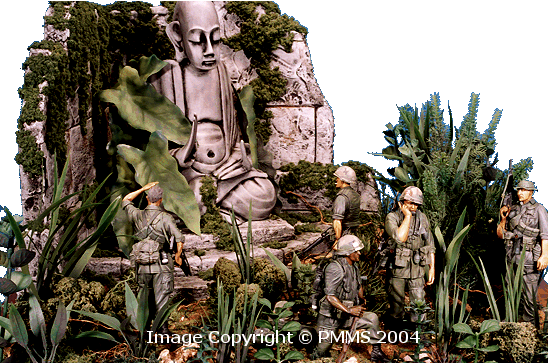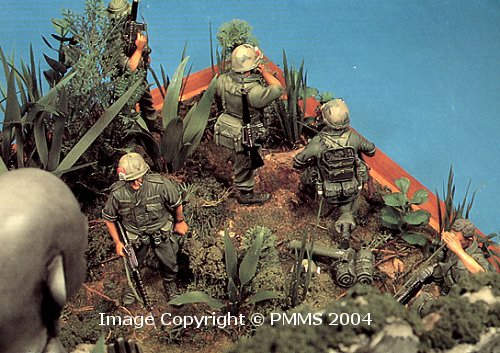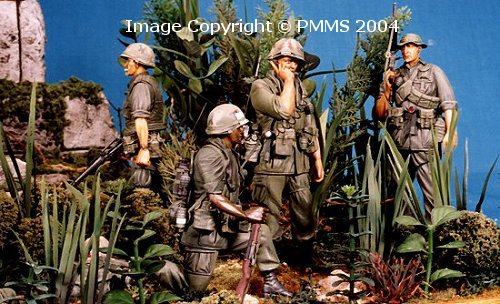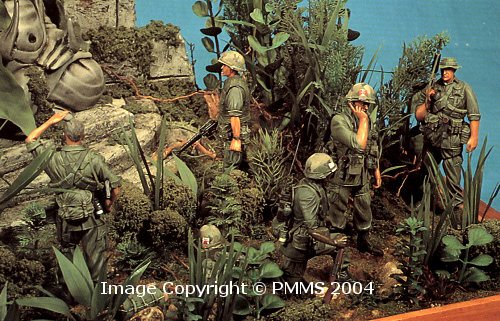
| "Confronting
Buddah" Vietnam - 1969 Diorama by Terry Ashley Scale 120mm |
 |


| "Confronting
Buddah" Vietnam - 1969 Diorama by Terry Ashley Scale 120mm |
 |

I have always had an interest
in the Vietnam War and with the release of Verlinden Productions 120mm range
of figures and weapons from that era, I started to plan a larger diorama.
Initially the figures were painted as separate figures, each being slightly
modified to make them different from the standard kit.
As the range of figures grew so did my plans, all that was needed was some-thing
to add to the figures as there is not much in the way of accessories available
in this scale.
When a friend turned up a large Buddha statue (bought during a trip to South-East
Asia), along the lines of Verlinden's Buddha in 1/35th, the diorama was born.
The scene is set somewhere deep in the jungles of Vietnam near the Cambodian
border. A patrol has just stumbled upon an abandoned temple and are taking a
break, to refresh and report back to base.
 The
Figures
The
Figures
The figures are a mish-mash
of various figure parts plus some modifications and additions.
Figure
1 - M60 Machine Gunner
The torso is from
kit N°466 "Airborne GI" as are the arms, the right being modified to take the
M60 (Kit N°502).The legs are from kit N° 458 "Radio Operator", with a head taken
from the bare heads" set. The sling for the M60 is made from lead sheet
Figure2
- RTO (Radio Telephone Operator).
This is the most heavily
modified figure, being converted to a kneeling position to add a bit of animation
instead of having all standing figures. The torso is from a "Radio Operator"
kit, with the arms from the "Airborne Gl" kit, suitably modified to fit. The
legs are also from the Airborne kit, firstly using a razor saw the two legs
are separated and then cut at the knees.
After removing enough of the leg to get the required position they are then
secured with epoxy glue and the resulting gaps filled with excess resin pieces
and body filler putty.
It is then a process of sanding to shape and adding new cloth folds to correspond
with the new positioning.
The head is from the Airborne Gl with a lead sheet towel added around his neck.
Finally a rucksack frame was built from thin rod solder (very easy to work with
and to obtain natural bends) to carry the radio and additional gear.
 Figure
3 - GI with Flack Jacket
Figure
3 - GI with Flack Jacket
The torso and legs are from
kit N°445 'US Chopper crewman/ Vietnam", as is the left arm.
The right arm has the sleeve from the Chopper Crewman with the arm, M16 and
head from kit N°466 "Airborne Gl", these fitting together without further modification.
Figure
4 - Squad Leader/Radio Operator
This figure is
a stock standard kit N°458 "US Radio Operator/ Vietnam", the only addition
being a towel around his neck made from lead sheet.
Figure
5 - Gl with CAR-15
The torso and the legs are
from Kit N°466 "US Airborne Gl/Vietnam". Both arms are from kit N°458 "Radio
Operator" suitably modified to fit the new torso and also to hold the weapon.
Some trial fitting is required to ensure the new arms will fit around his personal
gear and the CAR-15 'sits' naturally in the hand. The head is from kit N°465
"Bare Heads" with a bush hat made from lead sheet.
All the personal gear, weapons etc., are either from the figure kits or from
kit N°460 "US Infantry Gear & Weapons/Vietnam". All weapons have the barrels
drilled out and slings added from lead sheet. Painting was with oils for all
flesh areas and Humbrol enamels for the uniforms and equipment.
In all, parts of 6 figures were used to make up the 5 used in the diorama.
 The BUDDHA
and Ground Work
The BUDDHA
and Ground Work
The statue is a
wooden Buddha unmodified from its original form and painted with Humbrol Enamels
and weathered with oils.
This was mounted on a platform and walls made from foam packing coated with
plaster, with the stonework engraved. Again the walls were painted in enamels
and weathered using an oil paint wash.
Using the sandwich method for the walls results in the finished article being
light in weight for its large size. (The diorama measuring 410mm square and
280mm in height.) Next the groundwork was built up on a plaster base using various
types of ground scatter/grasses to give a contrasting effect.
Small clumps of lichen were added and the plants, various commercially available
plastic aquarium plants along with some of the Verlinden jungle plants all sprayed
with differing shades of green from dark on the undersides to lighter on top
and toward the end of the leaves.
The clinging vines on the walls are clumps of coarse turf soaked in white glue
and attached to the walls. Additional vines and bits of tree branches were added
using dried out root systems from various garden plants.
The finished diorama took a little over three months to build and the end result is a self-satisfying model.